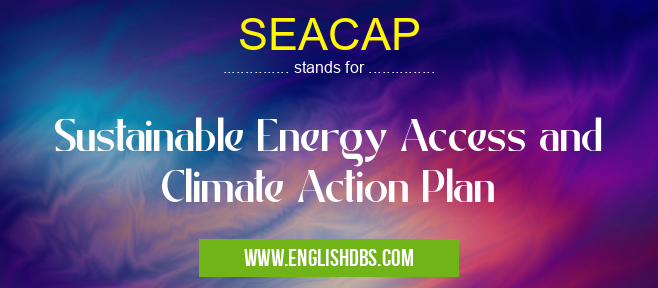What does SEACAP mean in CLIMATE
The Sustainable Energy Access and Climate Action Plan (SEACAP) is a comprehensive strategy to ensure equitable access to safe, affordable, and clean energy while meeting the global climate change challenge. SEACAP seeks to drive investments in renewable energy technologies, reduce emissions of greenhouse gases, reduce air pollution that contributes to climate change, and ensure that the most vulnerable countries are not left behind by the transition to a low-carbon economy.

SEACAP meaning in Climate in Academic & Science
SEACAP mostly used in an acronym Climate in Category Academic & Science that means Sustainable Energy Access and Climate Action Plan
Shorthand: SEACAP,
Full Form: Sustainable Energy Access and Climate Action Plan
For more information of "Sustainable Energy Access and Climate Action Plan", see the section below.
Goals
SEACAP seeks to accomplish three main objectives: increasing access to modern energy services; reducing emissions of greenhouse gases; and improving air quality. The plan looks at both short-term goals such as establishing financing mechanisms and deploying new renewable energy technologies; as well as long-term objectives such as developing markets for innovative green products or services. To ensure its effectiveness, SEACAP applies an integrated approach which takes into account economic factors, local conditions and availability of resources. This ensures that no one country is left behind during the transition toward a cleaner economy.
Essential Questions and Answers on Sustainable Energy Access and Climate Action Plan in "SCIENCE»CLIMATE"
What is SEACAP?
SEACAP stands for Sustainable Energy Access and Climate Action Plan. It is a global initiative that works to promote energy access and climate change mitigation worldwide. The goal of the program is to increase energy access for people living in energy-poor regions, while reducing greenhouse gas emissions associated with energy production, distribution, and use.
How does SEACAP help reduce greenhouse gas emissions?
SEACAP provides resources to countries and communities that are working to reduce their dependence on fossil fuels. This can include providing access to renewable energy sources such as solar and wind power, as well as technology that helps improve efficiency of existing systems such as heat pumps and waste management systems. By using these solutions, emissions related to energy production, distribution, and use can be significantly reduced.
Who implements SEACAP?
SEACAP is implemented through governments, non-government organizations (NGOs), businesses and local communities who join forces to create action plans that have both environmental sustainability benefits and alleviate energy poverty in the world's poorest regions.
What are some examples of an SEACAP action plan?
Some examples of an action plan could include initiatives such as solar rooftop installations, fuel switching from traditional sources such as coal or wood burning stoves to more efficient renewables sources like solar or wind power, improving access to efficient cooking stoves or refrigerators in rural areas, establishing smart grids with large storage capacity for renewable sources or creating trade agreements between nations for sustainable energy goods.
Why should I care about SEACAP?
Our current global climate crisis requires immediate collective action from all levels - from individuals like you down to governments around the world - if we want any chance at avoiding dangerous consequences of our changing environment. By implementing sustainable solutions proposed by an SEACAP Action Plan at a local level it will not only benefit those specific communities but also contribute positively towards global goals for reducing carbon emission levels in the atmosphere which in turn helps protect our planet's health for future generations.
How does one get involved with the implementation of an SEACAP Action Plan?
Depending on your level of involvement there are different pathways you can take. If you are interested at a governmental level there may be opportunities available locally through government organizations who are focused on sustainable development goals (SDG). For more grassroots action joining a non-government organization can provide ways in which you can get involved with devising your own sustainable projects which would then require funding through grant schemes or partnerships with businesses who might share your vision.
Where do I find information about funding opportunities related to creating an SEANCAP Action Plan?
There are multiple online resources available from various international organizations that list grant schemes activities offered by donor countries or private companies looking for investments into projects associated with clean energy access development or climate change adaptation programs. Additionally searching for relevant research papers or attending conferences related to this field might provide additional insights into where one could contact for further information.
Can private companies also help implement an SEANCAP Action Plan?
Yes! Private companies often have the experience necessary when it comes to setting up renewable energy infrastructure or providing technical advice on how best go about developing effective solutions needed meet the demands outlined in an action plan created under the sustainable framework provided by SEANCAP initiatives.
Final Words:
SEACAP provides an ambitious blueprint for how we can address climate change while still ensuring equitable access to clean energy sources for everyone around the world. Its goal of mitigating climate change through renewable energy innovation is both necessary and achievable - provided that all stakeholders work together to implement this plan without delay. By doing so, we will be able to build a better future for our planet - one where clean technology choices bring us closer together rather than driving us apart.
